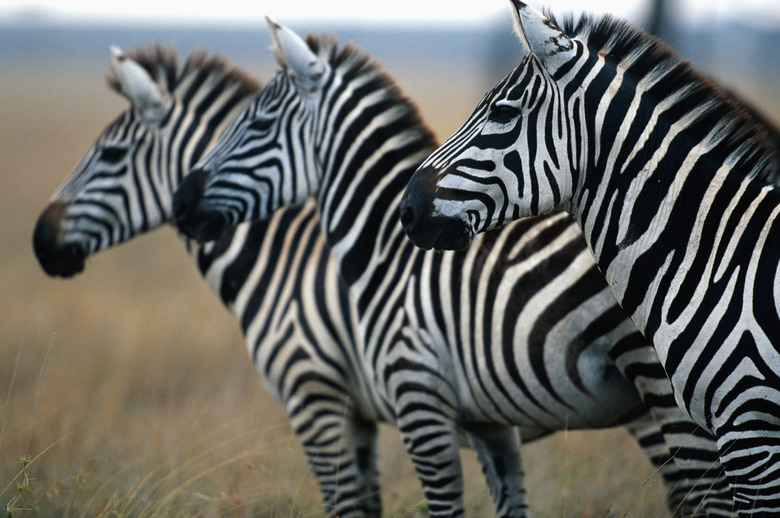Animals That Are Carnivores
Animals that eat meat only – or at least mostly meat – are broadly classified as carnivores, a general ecological category alongside herbivores (plant-eaters), omnivores (which consume both plant and animal matter) and detritivores (organisms that break down dead organic matter). The word "carnivore" probably flashes to mind such big and formidable predatory beasts as Bengal tigers or great white sharks, but the vast majority of organisms falling under this label are much more modestly proportioned: from little insect-eating songbirds and shrews to downright tiny predatory nematodes or beetles.
It's easy to get a little confused about the relationship between the general term "carnivore" and the specific order of mammals called the Carnivora. Carnivora is a taxonomic grouping; that is, it lumps together species based on their relationship on the tree of life. It's true that many members of Carnivora well exemplify the carnivore definition – Carnivora means "eaters of flesh," after all – including cats, spotted hyenas, pinnipeds (seals, sea lions and walruses) and many weasels, dogs, civets and mongooses. But a whole host of them are omnivores and some – the giant panda, for example – primarily consume vegetation. Furthermore, other mammalian orders certainly include carnivorous members; one, Cetacea (whales and dolphins), is an exclusively carnivorous grouping – much more exclusively carnivorous than Carnivora, in fact. While "carnivore" is sometimes used as shorthand for a member of Carnivora, the more accurate term is "carnivoran."
Many carnivores, meanwhile, can also be classified as "predators," which are animals that actively hunt live meat. But most carnivores also readily fall into the "scavenger" category by opportunistically consuming dead animals (carrion). Because carrion is a rather hit-or-miss food source, there aren't all that many "pure" (obligate) scavengers, though blowflies, burying beetles, certain marine amphipods and most vultures are examples.
Finally, when its position in the food web is considered, a carnivore could also be called a secondary consumer (if it eats primary consumers, organisms that feed on primary producers, such as green plants) or a tertiary consumer (if it eats secondary consumers), which includes those carnivores that prey on other carnivores.
Obligate vs. Facultative Carnivore Examples
Obligate carnivores – sometimes called "hypercarnivores" – are those with diets mostly, sometimes exclusively, composed of meat. Examples include cats (felids), pinnipeds, raptors (birds of prey), snakes, crocodilians, sharks and nearly all spiders. Facultative carnivores are those that include significant amounts of plant material in their diet. Most dogs (canids), for example, are facultative carnivores, though gray wolves and African wild dogs (painted hunting dogs) are hypercarnivorous. Facultative carnivores that eat particularly large proportions of plant matter alongside meat, such as many bears, are more commonly simply called omnivores.
Carnivore Adaptations
Because only a small proportion – often very roughly generalized as 10 percent – of energy gets transferred up the links of a food web, an ecosystem can support many more plants (primary producers, in energy or trophic terms) than herbivores, and many more herbivores than carnivores. It follows that carnivorous animals, generally speaking, must expend more energy than your average herbivore in tracking down its less-abundant food. If that carnivore is a predator, it also must often (though not always) expend considerable additional energy actually catching and subduing its prey.
Thus the design of a typical carnivore revolves heavily around detecting animal matter and, if necessary, dispatching it. A turkey vulture has an enlarged olfactory bulb for an enhanced sense of smell: ideal for sniffing out rotting meat to scavenge. Spiders and some snakes possess a venomous bite to weaken or kill prey. Special organs allow sharks to sense both the electromagnetic fields and movement of fish and other quarry. Lions, pumas and other cats have sharp, retractable claws and sharp, pronounced canine teeth for killing.
Many carnivores are much larger than the animals they consume: A great blue heron is much bigger than a sculpin, a gecko much bigger than a moth, a blue whale – to take the extreme example of filter-feeders – much, much bigger than a krill. Some carnivores, however, hunt proportionately large prey, even prey that may significantly outsize them. They may do this by brute force – a weasel slaying a rabbit, a tiger wrestling down a water buffalo – or by hunting cooperatively, as when a pack of dholes (Asian wild dogs) pursues sambar deer or when a pod of orcas targets a full-grown baleen whale.
Cite This Article
MLA
Shaw, Ethan. "Animals That Are Carnivores" sciencing.com, https://www.sciencing.com/animals-carnivores-8125484/. 19 August 2018.
APA
Shaw, Ethan. (2018, August 19). Animals That Are Carnivores. sciencing.com. Retrieved from https://www.sciencing.com/animals-carnivores-8125484/
Chicago
Shaw, Ethan. Animals That Are Carnivores last modified March 24, 2022. https://www.sciencing.com/animals-carnivores-8125484/
